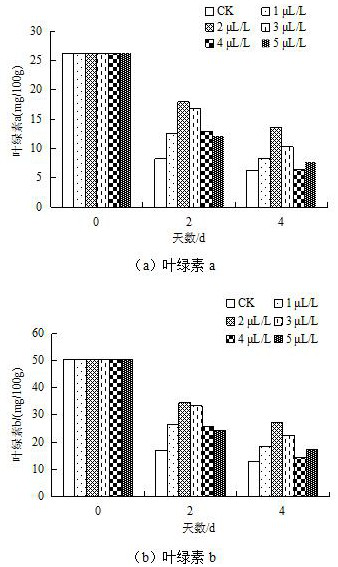Fresh-cut cabbage preservation method and application thereof
A fresh-keeping method and cabbage technology are applied in the application, fruit and vegetable fresh-keeping, food preservation and other directions to achieve the effects of extending shelf life, inhibiting bag swelling and maintaining quality
- Summary
- Abstract
- Description
- Claims
- Application Information
AI Technical Summary
Problems solved by technology
Method used
Image
Examples
Embodiment 1
[0024] Screening of postharvest 1-MCP concentration in cabbage
[0025] After the cabbage was harvested, put it in a PE bag, put it in a 1-MCP fresh-keeping bag soaked in distilled water, seal it immediately, fumigate at 25 °C for 12 h, and store it at room temperature (25±1 °C) without adding 1 The cabbage in the -MCP fresh-keeping package was used as a control, denoted as CK, and the concentration of 1-MCP treatment was 1, 2, 3, 4, and 5 μL / L. Relevant indicators were measured every 2 d.
[0026] Table 1 shows the effects of different treatments of 1-MCP on sensory scores of cabbage during postharvest storage. During the whole storage period, the sensory changes of cabbage were mainly manifested as yellowing, rot and soft texture. It can be seen from Table 1 that the leaves of cabbage in the CK group turned yellow, had a serious odor, and were slightly rotted after 4 days of storage. The comprehensive sensory score of the cabbage in the CK group was 4.72, and the CK group ...
Embodiment 2
[0031] Optimization of the formulation of fresh-cut cabbage biological preservative
[0032] After the cabbage was harvested, put it in a PE bag, put it in a 1-MCP fresh-keeping bag (2 μL / L) soaked in distilled water, and seal it immediately. After fumigation at 25°C for 12 hours, the whole cabbage was cleaned and sliced, and then peeled off. Take the outer two layers of leaves of cabbage, take the 3rd to 5th layers and manually cut them into slices about 1 × 5 cm thick, soak them in biological preservative for 2 minutes, dry them naturally, then vacuum-pack them, and put them in a low temperature of 4-8°C. Store in shelf cabinets.
[0033] Based on the screening test of biological preservatives, papain, bromelain and ε-polylysine were selected as the three factors of the response surface test, and the sensory score of fresh-cut cabbage for 2 days was used as the response value to establish a three-factor and three-level test. , and the corresponding factors and levels are sh...
Embodiment 3
[0046] Comparison of post-harvest 1-MCP combined with biological preservatives
[0047] After the cabbage was harvested, put it in a PE bag, put it in a 1-MCP fresh-keeping bag (2 μL / L) soaked in distilled water, and seal it immediately. After fumigation at 25°C for 12 hours, the whole cabbage was cleaned and sliced, and then peeled off. Take the outer two layers of leaves of cabbage, take the 3rd to 5th layers and manually cut them into slices about 1 × 5 cm thick, soak them in biological preservative for 2 minutes, dry them naturally, then vacuum-pack them, and put them in a low temperature of 4-8°C. Store in shelf cabinets. Treatment 1: no 1-MCP treatment and soaking in biological preservatives, denoted CK; treatment 2: only soaking in biological preservatives, denoted F; treatment 3: only 1-MCP treatment, denoted 1-MCP; treatment 4: 1- MCP treatment and soaking in biological preservatives, denoted 1-MCP-F.
[0048] figure 2 is the change in browning degree of fresh-cut...
PUM
 Login to View More
Login to View More Abstract
Description
Claims
Application Information
 Login to View More
Login to View More - R&D
- Intellectual Property
- Life Sciences
- Materials
- Tech Scout
- Unparalleled Data Quality
- Higher Quality Content
- 60% Fewer Hallucinations
Browse by: Latest US Patents, China's latest patents, Technical Efficacy Thesaurus, Application Domain, Technology Topic, Popular Technical Reports.
© 2025 PatSnap. All rights reserved.Legal|Privacy policy|Modern Slavery Act Transparency Statement|Sitemap|About US| Contact US: help@patsnap.com



